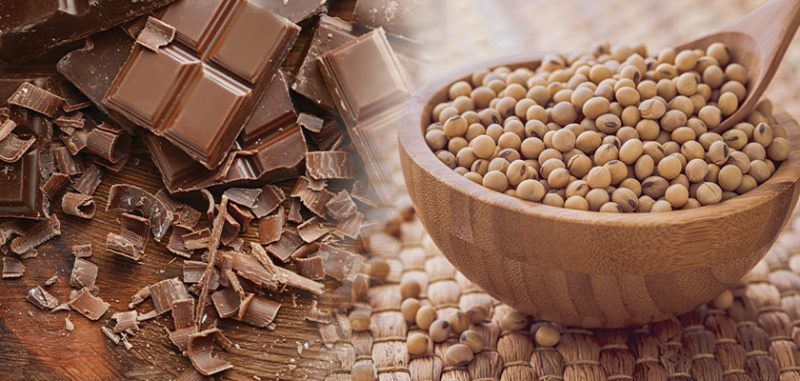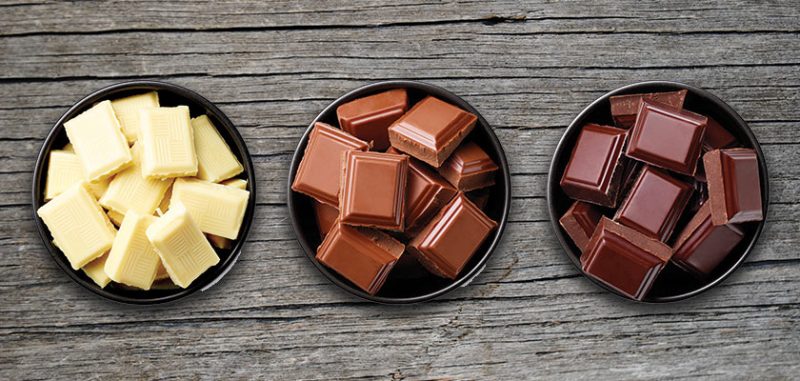As a bean-to-bar chocolate maker, knowing how to choose the right cocoa beans is vital. In this article, Chef Prish explains what are cocoa beans, types of cocoa beans used for chocolate-making, and how to choose the best ones.
What are Cocoa Beans?
Cacao “beans” (aka cocoa beans) are technically cacao seeds, cushioned within the fresh, fruity pulped pods of the theobroma, (“food for the gods”) tree. They originated in the upper Amazon areas of Peru, Ecuador, and Colombia and are now also cultivated in some parts of West Africa and Asia. Before the glorious culinary application of the seed was discovered, it was the sweet white pulp that was favored for its nutritious juice.
Upon its discovery, 5300 years ago, the cacao bean itself was revered as a personification of divine feminine energy and played a pivotal role in Mesoamerican mythology. It was used ritualistically in initiation, death, marriage, and birthing rituals. Archeological artifacts show cacao pods engraved on the surface of drinking vessels, and formed on stone effigies. Even sacrificial victims were garlanded with necklaces of cacao. In the 14th century, the Aztecs and Mayans started using cacao as a valuable means of currency.
What are cocoa beans used for?
When Spanish explorer, Hernan Cortes was introduced to the stoneground, ceremonial cacao libation by the Aztec Emperor, Moctezuma Xocoyotzin in 1528, he was instantly seduced by its elevating, aphrodisiac properties. He took the seeds back to Spain, where sugar, honey, vanilla, and cinnamon were added to the prepared cacao drink, instead of the traditional South American maize. “Chocolate” as we know it now, was born.
Through the ages, cacao farming and processing methods were streamlined, and now, we have the absolute ease of producing chocolate from cocoa beans in our own home kitchens. Today, cacao is also enjoyed in the form of raw nibs as is, and cocoa powder in baking and beverages, although in this article the focus is predominantly on using cocoa beans for chocolate-making.
Although there are about ten varieties, in this article, we will focus on the three that are produced for chocolate, Criollo, Trinitario, and Forastero. Let’s find out the differences between each major variety and how to choose the right cocoa beans for chocolate making.
The Three Major Varieties of Cocoa Beans for Chocolate
According to Mark Christian, Founder of C-Spot, the Independent Guide to Premium Chocolate,
“Cacáo is notoriously promiscuous, engendering classification nightmares, & often plain guesswork. With so much genetic cross-pollination, hybridization, mutation, & recombination, it’s rare & increasingly difficult to find any pure forms.”
In the future, classification will be based on country origin, or bean cultivar, rather than primary variety names. Nonetheless, knowledge of varietal identification is essential to producing a refined product, so let’s examine them.
Criollo cacao beans
Originating in Central and South America, Criollo, a boutique variety, and the connoisseur’s favorite is considered rare and expensive. The low-yielding pods produce an average of 30 – 50 seeds. They only comprise 1% – 5% of global production due to their susceptibility to disease and temperamentality in cultivated environments. Criollo has over 230 antioxidants, the most out of all varieties. Its flavor profile is rich, smooth, and decadent. Attributes include fruit, nuts, bread, and cream. Its low acidity is due to fewer tannins. It requires a shorter fermentation period and the quickest low-temperature roast. To identity Criollo, look for long, yellow pods which turn deep red when ripe.
Forastero cacao beans
Forastero is the most prolific of all beans. It is disease-resistant, cheap, and versatile. It mainly grows in Africa, Ecuador, and Brazil. 90% of the world’s chocolate comes from this bulk variety. Its taste is often described as bland and bitter without secondary flavors and as a result, it is often blended with other varieties to enhance its flavor. To identify the Forastero bean, look for short, yellow pods with shallow ridges and bitter-tasting purple beans.
Trinitario cacao beans
Trinitario, thus named by the Spanish, and meaning, “from Trinidad,” is a hybrid between Criollo and Forastero. It contains the best of both worlds, the disease resistance of Forastero, and some of the refined flavor qualities of Criollo. Trinitario is found in central and South America and some parts of Asia. It makes up about 10% of the world’s production.
The ratio of Criollo to Forastero and the climate in which it grows determines the flavor profile of Trinitario. Trinidad and Tobago produce seed council-approved clone varieties of Trinitario, as well. Because of these varying factors, the pods and beans differ in color and shape. The flavor profile of Trinitario is earthy, spicy, and fruity.
How to Choose Cocoa Beans for Chocolate
The Fundamentals of Healthy Cacao Bean Inspection
Before selecting high-quality, properly fermented, and dried beans, examine their appearance. A good bean should have a sheen, volume, a clean snap, and a pleasant aroma. Please avoid beans with:
- white coloration – a sign of mold
- black beans – fungal infections
- flat beans
- beans that clump together
- slaty/ gray/ violet beans
- foreign debris like bits of wood, glass, or stones
Next, examine the inside of the bean by doing a cut test. Cut tests are the international standard for assessing bean quality and every country has its own stringent standards. Slice the bean open along the vertical seam using a knife, pruning shears, or a cacao guillotine cutter. Check its coloration and fissures. See the image below which identifies good and poor-quality beans in a cut test.

Next, smell the beans and look out for the following aromatic indicators:
| Cacao Positive Aromas | Cacao Negative Aromas* |
|---|---|
| fruity | leathery |
| nutty | animal-like |
| sour | rancid |
| chocolatey | smokey |
| floral |
*These negative attributes are a sign of over-fermentation and/or mishandling during storage.
What are Cocoa Beans Comprised Of? Sugar, Fat & Acid
Acidity
Analysing sugar, fat, and acid in cacao can take you down a rabbit hole. If you focused on acidity alone, you’d find that cacao contains quite a few different kinds of acid – acetic, citric, lactic, malic, oxalic, propionic, succinic, and tartaric acids. Acidity plays a huge role in flavor composition. Lactic and acetic acids are higher in South East Asian and South Pacific cocoa beans. West African cocoa beans are less acidic. The modulation of oxalic acid determines the flavor of chocolate. It is important to keep note of this when sourcing your beans.
Sugar content
The sugar content in cacao is very low, most of it concentrated in the pulp, but even the low sugar content in the bean is affected by the kind of fermentation methods used. Manual fermentation reduces sugars more than semi-mechanized methods. Also, the climate in which it happens contributes to sugar balance. Further, in roasting, the Malliard reaction also reduces sugar content. Speak to your supplier about how the beans were fermented and how long the roasting period was, as well as the average temperature.
Fat content
The fat content in the bean is affected much in the same way as sugar and acid are. For high-quality beans, make sure the packaging used during storage is transparent polythene film (TPEH) which was scientifically measured against black non-transparent polythene film (BNTPEF), and NA (normal atmosphere environment) packaging. Fat content was most stable in TPEH packaging.
Choosing the Right Blend of Cocoa Beans for Chocolate
When choosing the right beans for chocolate making, focus on creating the blend that results in “fine flavor.” The International Cocoa Organization, ICCO, defines fine flavor as,
“including fruit (fresh and browned, mature fruits), floral, herbal, and wood notes, nut and caramelic notes as well as rich and balanced chocolate bases.”
Taste is subjective, so trust your palate. If you are someone who prefers smokey whiskey, tobacco, wood, and dark, bitter coffee, then you will probably lean towards deeper-roasted, full-bodied chocolate with bitter notes. However, if you prefer champagne, tangerines, strawberries, and cream, perhaps you will prefer a lighter roast with fruitier and playfully acidic tones. There are no rights or wrongs, and if anything it is a grand adventure to embark upon, considering the diversity of cultivars and clones, each farm’s post-harvesting protocols, and your particular goals with chocolate-making.
Taste all the chocolate you can, and take notes:
- What did you like about each one?
- What made one stand out above the others?
- Can you break its flavor profile down into as many components as possible?
- Can you think about what other flavors can enhance your favorite picks and which beans to source to build the perfect, most cohesive complement?
Also, think about what you don’t like so you know exactly what to avoid. Define it to as detailed a quotient as you can so that the decision-making soon becomes instinctual.
Final Thoughts on What are Cocoa Beans & How to Choose Cocoa Beans for Chocolate
We hope you’ve enjoyed this article by Chef Prish on What are cocoa beans: the art and science of choosing cocoa beans for chocolate.
If you’re ready to choose your beans and start making, we suggest you check out our articles on how to make cocoa powder from cocoa beans to learn the preparation, fermentation and roasting process, and how to make chocolate from cocoa beans (bean to bar).
Happy Chocolatiering!








